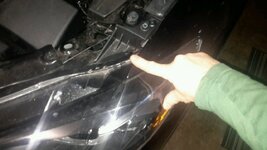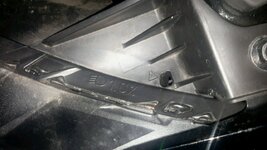Headlight aiming on the HIDS in FSM states this.
HEADLIGHT AUTO LEVELING SYSTEM INITIALIZATION
NOTE:
The AFS control module records the vehicle height while it is unoccupied by performing the headlight auto leveling system initial setting.
Perform headlight auto leveling system initial setting if any of the following work is performed.
AFS control module replacement
Auto leveling sensor replacement, removal/installation
Work that can affect vehicle height such as suspension replacement or removal/installation.
There are two types of procedures for headlight auto leveling system initial setting, one which uses the M-MDS and the other which does not use it.
When using the M-MDS
1. Empty the vehicle by having all occupants leave the vehicle and remove all the cargo except for the spare tire, jack and tools equipped on the vehicle.
2. Adjust the air pressure of each tire to the specified value. (See WHEEL AND TIRE SPECIFICATION .)
3. Move the vehicle to level ground.
4. Connect the M-MDS to the DLC-2.
5. After vehicle identification, select in the following order from the M-MDS initial screen. NOTE:
The AFS OFF indicator light continues flashing during the first initial setting, however, continue the work because it does not indicate an improper procedure.
a. “Electrical”
b. “ExteriorLighting”
c. “Headlamp”
d. “Auto Leveling Sensor”
e. “Auto Leveling Sensors Calibration”
6. Verify that the AFS OFF indicator light flashes three times at 0.25 s intervals and turns off as shown in the figure.
7. Adjust the headlight aiming. (See HEADLIGHT AIMING.) When not using the M-MDS
CAUTION:
1. Empty the vehicle by having all occupants leave the vehicle and remove all the cargo except for the spare tire, jack and tools equipped on the vehicle.
Perform Steps 3-4 within 30 s.
2. Adjust the air pressure of each tire to the specified value. (See WHEEL AND TIRE SPECIFICATION .)
3. Switch the ignition ON (engine off or on).
NOTE:
4. Using a jumper wire, connect DLC-2 terminals B and J (ground) three times at 0.5 to 1.5 s intervals as shown in the figure.
CAUTION:
The AFS OFF indicator light continues flashing during the first initial setting, however, continue the work because it does not indicate an improper procedure.
If the terminals are mistakenly connected, vehicle damage or fire could occur. When connecting with the jumper wire, thoroughly verify what terminals are being connected to prevent a miss-connection.
MyManualDownload.com
5. Verify the AFS OFF indicator light.
If the AFS OFF indicator light flashes three times at 0.25 s intervals and turns off as shown in the figure, the initial setting is completed. Go to the next step.
If the AFS OFF indicator light continues flashing, the procedure may be performed incorrectly. Repeat the procedure from Step 1.
If the AFS OFF indicator light is illuminated, the headlight auto leveling system may have a malfunction. Perform the DTC inspection. (See DTC INSPECTION [ADAPTIVE FRONT LIGHTING SYSTEM (AFS)].)
Repair or replace the malfunctioning area, then repeat the procedure from Step 1.
6. Adjust the headlight aiming. (See HEADLIGHT AIMING.)
2015 - CX-5 - Body and Accessories
HEADLIGHT AIMING
NOTE:
1. Empty the vehicle by having all occupants leave the vehicle and remove all the cargo except for the spare tire, jack and tools equipped on the vehicle.
2. Adjust the air pressure of each tire to the specified value. (See WHEEL AND TIRE SPECIFICATION.) 3. Move the vehicle to level ground.
4. Make a screen shown in the figure using double-weight, white paper.
5. Line up the vehicle with the wall so that the distance to the headlights is 3 m {9.8 ft} from the wall.
6. Measure the height at the center point of the headlight.
7. Align the center of the headlight with the center of the screen.
Measure the height at the center point of the headlight in which the aiming is being adjusted because the vehicle height differs depending on vehicle conditions.
8. Set a partition in front of the headlight which is not being adjusted to block the light.
9. Start the engine and charge the battery.
10. Turn on the headlight low beams.
11. Verify that the elbow point of the headlight is at the position indicated on the adjustment screen.
If the elbow point of the headlight is not at the position indicated on the adjustment screen, perform the following adjustment.
a. Rotate the adjustment screw to adjust the headlight.
No idea if aiming is the same on LEDs as HIDs.




